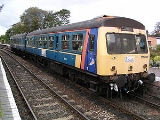
ScotRail
Encyclopedia
ScotRail was a brand name used for all Scottish
regional and commuter rail services, including some cross-border services, from 1997 to 2004.
Created by manager Chris Green
, the brand was adopted by National Express
when it took over the franchise from British Rail
in 1997. First Group subsequently revised the brand under the name First ScotRail
when it took over the franchise on 17 October 2004, having outbid National Express.
DMU
s by British Rail and later Class 170 DMUs by National Express, services were operated by slam-door stock such as the Class 101
DMUs.
ScotRail - to replace slam door stock - received 46 Class 158 units from 1989–1992, and post privatisation, National Express ordered a total of 55 Class 170 units from 1999-2004 (First would receive the last of the units ordered by National Express and would later transfer 4 units from its Hull Trains subsidiary) and by 2004, the only slam door services were also the only locomotive hauled services, the Caledonian Sleeper services from London to Edinburgh, Glasgow, Aberdeen, Inverness and Fort William along with a single regional service between Edinburgh Waverley and North Berwick. First ScotRail have since leased electric multiple units to run between Edinburgh and North Berwick.
ScotRail, since privatisation, has contracted EWS to haul the Caledonian Sleeper
between London and Scotland. EWS operate a dedicated pool of 5 Class 90
electric locomotives to haul the Caledonian Sleeper between London Euston and Edinburgh Waverley and Glasgow Central, together with a fleet of Class 67
diesel locomotives to haul the various sleeper portions north of Edinburgh and Glasgow. When British Rail and National Express ran ScotRail, Class 37
diesel locomotives were used in place of the Class 67 locomotives, an arrangement which continued under First Group through to 2006.
Executive livery. The red stripe was replaced with a saltire blue stripe, and the InterCity name was replaced with the ScotRail name. Diesel and Electric multiple units carried normal versions of the Regional Railways livery.
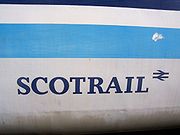
electric units retained it until withdrawal in 2001. The latter were replaced by ex-Stansted Skytrain
Class 322
units which were never repainted under the National Express franchise, receiving only ScotRail logo transfers. When the Class 322 hire ended in 2004, they were replaced on the North Berwick branch by EWS Class 90
electric locomotive
s hauling former Virgin Trains
Mk.3 coaching stock
, in the old Virgin red and grey livery, again with ScotRail logo transfers.
locomotives used on Caledonian Sleeper services.
has come up with a new livery which will be applied to all of Scotland's trains, when they go into maintenance. Unit 170434 has already been painted into the new livery. The new livery is dark blue background, with grey doors and a white dotted 'Saltire' Scottish flag. A new logo is also applied, ScotRail, with the tag line 'Scotland's Railway'. Stations and staff uniforms are also getting a new look - dark blue. This livery is not going to be replaced when the franchise ends, the only branding showing the operator will be a small " ScotRail is operated by" sign on the station building and on the train doors.
Scotland
Scotland is a country that is part of the United Kingdom. Occupying the northern third of the island of Great Britain, it shares a border with England to the south and is bounded by the North Sea to the east, the Atlantic Ocean to the north and west, and the North Channel and Irish Sea to the...
regional and commuter rail services, including some cross-border services, from 1997 to 2004.
Created by manager Chris Green
Chris Green (railway manager)
Chris Green is a British railway manager. He has a reputation for the adoption of business-led management of passenger services both in the British Rail and privatised eras, and has been described as "the best chairman BR never had"....
, the brand was adopted by National Express
National Express
National Express Coaches, more commonly known as National Express, is a brand and company, owned by the National Express Group, under which the majority of long distance bus and coach services in Great Britain are operated,...
when it took over the franchise from British Rail
British Rail
British Railways , which from 1965 traded as British Rail, was the operator of most of the rail transport in Great Britain between 1948 and 1997. It was formed from the nationalisation of the "Big Four" British railway companies and lasted until the gradual privatisation of British Rail, in stages...
in 1997. First Group subsequently revised the brand under the name First ScotRail
First ScotRail
ScotRail Railways Ltd. is the FirstGroup-owned train operating company running domestic passenger trains within Scotland, northern England and the cross-border Caledonian Sleeper service to London using the brand ScotRail which is the property of the Scottish Government...
when it took over the franchise on 17 October 2004, having outbid National Express.
Fleet
When ScotRail was created by BR, services were operated by a variety of diesel locomotives and coaching stock together with diesel and electric multiple units. Prior to the introduction of Class 158British Rail Class 158
British Rail Class 158 Express Sprinter is a diesel multiple-unit train, built for British Rail between 1989 and 1992 by BREL at its Derby Works. They were built to replace many locomotive-hauled passenger trains, and allowed cascading of existing Sprinter units to replace elderly 'heritage' DMUs...
DMU
Diesel multiple unit
A diesel multiple unit or DMU is a multiple unit train consisting of multiple carriages powered by one or more on-board diesel engines. They may also be referred to as a railcar or railmotor, depending on country.-Design:...
s by British Rail and later Class 170 DMUs by National Express, services were operated by slam-door stock such as the Class 101
British Rail Class 101
The British Rail Class 101 diesel multiple units were built by Metro-Cammell at Washwood Heath in Birmingham from 1956 to 1959, following construction of a series of prototype units. This class proved to be the most successful and longest-lived of all BR's First Generation DMUs, with the final five...
DMUs.
ScotRail - to replace slam door stock - received 46 Class 158 units from 1989–1992, and post privatisation, National Express ordered a total of 55 Class 170 units from 1999-2004 (First would receive the last of the units ordered by National Express and would later transfer 4 units from its Hull Trains subsidiary) and by 2004, the only slam door services were also the only locomotive hauled services, the Caledonian Sleeper services from London to Edinburgh, Glasgow, Aberdeen, Inverness and Fort William along with a single regional service between Edinburgh Waverley and North Berwick. First ScotRail have since leased electric multiple units to run between Edinburgh and North Berwick.
ScotRail, since privatisation, has contracted EWS to haul the Caledonian Sleeper
Caledonian Sleeper
The Caledonian Sleeper is a sleeper train service operated by First ScotRail and one of only two remaining sleeper services running on the railways of Great Britain, the other being the Night Riviera....
between London and Scotland. EWS operate a dedicated pool of 5 Class 90
British Rail Class 90
The British Rail Class 90 electric locomotives were built by BREL at Crewe from 1987-1990. Each locomotive weighs 84.5 tonnes and has a top speed of . They operate from 25 kV AC overhead wires and produce...
electric locomotives to haul the Caledonian Sleeper between London Euston and Edinburgh Waverley and Glasgow Central, together with a fleet of Class 67
British Rail Class 67
The Class 67 locomotives are a class of Bo'Bo' diesel electric mainline locomotives which were built for the English, Welsh and Scottish Railway between 1999 to 2000 by Alstom at Meinfesa in Valencia, Spain with drive components from General Motors Diesel.Rail enthusiasts have nicknamed the class...
diesel locomotives to haul the various sleeper portions north of Edinburgh and Glasgow. When British Rail and National Express ran ScotRail, Class 37
British Rail Class 37
The British Rail Class 37 is a diesel-electric locomotive. Also known as the English Electric Type 3, the Class was ordered as part of the British Rail modernisation plan....
diesel locomotives were used in place of the Class 67 locomotives, an arrangement which continued under First Group through to 2006.
| Class | Image | Type | Top speed | Built | |
|---|---|---|---|---|---|
| mph | km/h | ||||
| Class 101 British Rail Class 101 The British Rail Class 101 diesel multiple units were built by Metro-Cammell at Washwood Heath in Birmingham from 1956 to 1959, following construction of a series of prototype units. This class proved to be the most successful and longest-lived of all BR's First Generation DMUs, with the final five... |
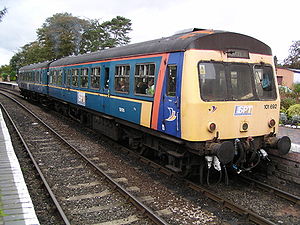 |
Diesel multiple unit Diesel multiple unit A diesel multiple unit or DMU is a multiple unit train consisting of multiple carriages powered by one or more on-board diesel engines. They may also be referred to as a railcar or railmotor, depending on country.-Design:... |
70 | 112 | 1956–1960 |
| Class 150 Sprinter British Rail Class 150 The British Rail Class 150 "Sprinter" diesel multiple units were built by BREL from 1984-87. A total of 137 units were built in three main subclasses, replacing many of the earlier first-generation "Heritage" DMUs.- Background :... |
 |
Diesel multiple unit Diesel multiple unit A diesel multiple unit or DMU is a multiple unit train consisting of multiple carriages powered by one or more on-board diesel engines. They may also be referred to as a railcar or railmotor, depending on country.-Design:... |
75 | 120 | 1984–1987 |
| Class 156 Super Sprinter British Rail Class 156 The British Rail Class 156 Super Sprinter is a diesel multiple-unit train . 114 of these units were built from 1987 to 1989 by Metro-Cammell at its Washwood Heath Works in Birmingham... |
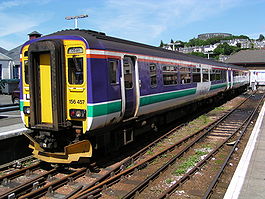 |
Diesel multiple unit Diesel multiple unit A diesel multiple unit or DMU is a multiple unit train consisting of multiple carriages powered by one or more on-board diesel engines. They may also be referred to as a railcar or railmotor, depending on country.-Design:... |
75 | 120 | 1987–1989 |
| Class 158 Express Sprinter British Rail Class 158 British Rail Class 158 Express Sprinter is a diesel multiple-unit train, built for British Rail between 1989 and 1992 by BREL at its Derby Works. They were built to replace many locomotive-hauled passenger trains, and allowed cascading of existing Sprinter units to replace elderly 'heritage' DMUs... |
 |
Diesel multiple unit Diesel multiple unit A diesel multiple unit or DMU is a multiple unit train consisting of multiple carriages powered by one or more on-board diesel engines. They may also be referred to as a railcar or railmotor, depending on country.-Design:... |
90 | 145 | 1989–1992 |
| Class 170 Turbostar |  |
Diesel multiple unit Diesel multiple unit A diesel multiple unit or DMU is a multiple unit train consisting of multiple carriages powered by one or more on-board diesel engines. They may also be referred to as a railcar or railmotor, depending on country.-Design:... |
100 | 160 | 1999-2004 |
| Class 303 Blue Train British Rail Class 303 The British Rail Class 303 electric multiple units, also known as "Blue Train" units, were introduced in 1960 for the electrification of the North Clyde and the Cathcart Circle lines in Strathclyde... |
Electric multiple unit Electric multiple unit An electric multiple unit or EMU is a multiple unit train consisting of self-propelled carriages, using electricity as the motive power. An EMU requires no separate locomotive, as electric traction motors are incorporated within one or a number of the carriages... |
75 | 120 | 1959–1961 | |
| Class 314 British Rail Class 314 British Rail Class 314 alternating current electric multiple units were built by BREL at York works in 1979. They were the third variety of British Rail's then-standard 1972 design for suburban EMUs, which eventually encompassed 755 vehicles and five classes... |
 |
Electric multiple unit Electric multiple unit An electric multiple unit or EMU is a multiple unit train consisting of self-propelled carriages, using electricity as the motive power. An EMU requires no separate locomotive, as electric traction motors are incorporated within one or a number of the carriages... |
75 | 120 | 1979 |
| Class 318 British Rail Class 318 The British Rail Class 318 is an electric multiple unit train, which operates exclusively in the Strathclyde Partnership for Transport network in West Central Scotland. The units were introduced fully on 29 September 1986 as part of the electrification of the Ayrshire Coast Line between and... |
 |
Electric multiple unit Electric multiple unit An electric multiple unit or EMU is a multiple unit train consisting of self-propelled carriages, using electricity as the motive power. An EMU requires no separate locomotive, as electric traction motors are incorporated within one or a number of the carriages... |
90 | 145 | 1986-1987 |
| Class 320 British Rail Class 320 The British Rail Class 320 is an alternating current electric multiple unit train found on the Strathclyde Partnership for Transport rail network in Central Scotland, and is used exclusively on the North Clyde Line between Helensburgh and Airdrie, North Lanarkshire via Glasgow Queen Street... |
Electric multiple unit Electric multiple unit An electric multiple unit or EMU is a multiple unit train consisting of self-propelled carriages, using electricity as the motive power. An EMU requires no separate locomotive, as electric traction motors are incorporated within one or a number of the carriages... |
75 | 120 | 1990 | |
| Class 322 British Rail Class 322 The British Rail Class 322 electric multiple units were built by BREL in 1990. Five 4-car units were built for the dedicated Stansted Express service from London Liverpool Street to Stansted Airport. The units were then used by First ScotRail, operating on the North Berwick Branch Line, between /... |
 |
Electric multiple unit Electric multiple unit An electric multiple unit or EMU is a multiple unit train consisting of self-propelled carriages, using electricity as the motive power. An EMU requires no separate locomotive, as electric traction motors are incorporated within one or a number of the carriages... |
100 | 160 | 1990 |
| Class 334 Juniper British Rail Class 334 The British Rail Class 334 is a suburban electric multiple unit built by Alstom in Birmingham. They are part of the Juniper family of trains along with Classes 458 and 460. They were built for SPT/ScotRail outer suburban services in Glasgow, UK. They later became part of First ScotRail/SPT fleet... |
 |
Electric multiple unit Electric multiple unit An electric multiple unit or EMU is a multiple unit train consisting of self-propelled carriages, using electricity as the motive power. An EMU requires no separate locomotive, as electric traction motors are incorporated within one or a number of the carriages... |
90 | 145 | 1999-2002 |
| Mk 2 Coach British Rail Mark 2 The Mark 2 family of railway carriages were British Rail's second design of carriages. They were built by British Rail workshops between 1964 and 1975... |
 |
Passenger Passenger A passenger is a term broadly used to describe any person who travels in a vehicle, but bears little or no responsibility for the tasks required for that vehicle to arrive at its destination.... Rolling stock Rolling stock Rolling stock comprises all the vehicles that move on a railway. It usually includes both powered and unpowered vehicles, for example locomotives, railroad cars, coaches and wagons... |
100 | 160 | 1969–1974 |
| Mk 3 Coach (Sleepers) British Rail Mark 3 British Rail's third design of standard carriage was designated 'Mark 3' , and was developed primarily for the InterCity 125 High Speed Train... |
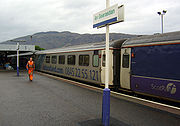 |
Passenger Passenger A passenger is a term broadly used to describe any person who travels in a vehicle, but bears little or no responsibility for the tasks required for that vehicle to arrive at its destination.... Rolling stock Rolling stock Rolling stock comprises all the vehicles that move on a railway. It usually includes both powered and unpowered vehicles, for example locomotives, railroad cars, coaches and wagons... |
125 | 200 | 1975–1988 |
BR
ScotRail, under BR used customised versions of the existing British Rail liveries, with passenger locomotives and coaching stock painted in a lightly modified version of the InterCityInterCity (British Rail)
InterCity was introduced by British Rail in 1966 as a brand-name for its long-haul express passenger services ....
Executive livery. The red stripe was replaced with a saltire blue stripe, and the InterCity name was replaced with the ScotRail name. Diesel and Electric multiple units carried normal versions of the Regional Railways livery.

National Express
The first unique ScotRail livery was introduced shortly after privatisation under National Express, who introduced their own livery. Initially, vehicles received the new ScotRail logo applied with vinyl stickers; a stylised outline of Scotland composed of three flashes in the corporate colours of green, red and purple. Multiple units were painted into the new livery with bodies in white (lower half) and purple (upper half) with green, red and white stripes bordering the purple, overlain by and a wide diagonal white band in the centre of the carriage. There were no units left with Regional Railways livery in Scotland at the end of the National Express franchise period, although the Class 305British Rail Class 305
The British Rail Class 305 was an alternating current electric multiple unit . Under the pre-1973 British Rail numbering system, the class was known as AM5...
electric units retained it until withdrawal in 2001. The latter were replaced by ex-Stansted Skytrain
Stansted Express
Stansted Express is a sub-brand of National Express East Anglia. It is the direct train service linking central London to Stansted Airport, one of London's major air hubs...
Class 322
British Rail Class 322
The British Rail Class 322 electric multiple units were built by BREL in 1990. Five 4-car units were built for the dedicated Stansted Express service from London Liverpool Street to Stansted Airport. The units were then used by First ScotRail, operating on the North Berwick Branch Line, between /...
units which were never repainted under the National Express franchise, receiving only ScotRail logo transfers. When the Class 322 hire ended in 2004, they were replaced on the North Berwick branch by EWS Class 90
British Rail Class 90
The British Rail Class 90 electric locomotives were built by BREL at Crewe from 1987-1990. Each locomotive weighs 84.5 tonnes and has a top speed of . They operate from 25 kV AC overhead wires and produce...
electric locomotive
Electric locomotive
An electric locomotive is a locomotive powered by electricity from overhead lines, a third rail or an on-board energy storage device...
s hauling former Virgin Trains
Virgin Trains
Virgin Trains is a train operating company in the United Kingdom. It operates long-distance passenger services on the West Coast Main Line between London, the West Midlands, North West England, North Wales and Scotland...
Mk.3 coaching stock
British Rail Mark 3
British Rail's third design of standard carriage was designated 'Mark 3' , and was developed primarily for the InterCity 125 High Speed Train...
, in the old Virgin red and grey livery, again with ScotRail logo transfers.
First
When First originally acquired the franchise, a new regional livery of pink, grey and purple and a new logo of a pink circle and an italicised "f" character was introduced. Legislation requiring train doors to be painted in a contrasting colour to the body for visually impaired passengers resulted in white doors with a pink stripe. Like National Express, First applied their logo on units by transfer until repainting. A large number of units were re-branded into this livery, including the Class 322 units re-acquired (and refurbished) for North Berwick service and the Class 90British Rail Class 90
The British Rail Class 90 electric locomotives were built by BREL at Crewe from 1987-1990. Each locomotive weighs 84.5 tonnes and has a top speed of . They operate from 25 kV AC overhead wires and produce...
locomotives used on Caledonian Sleeper services.
Transport Scotland
Transport ScotlandTransport Scotland
Transport Scotland was created on 1 January 2006 as the national transport agency of Scotland. It is an Executive Agency of the Scottish Government's Enterprise, Transport and Lifelong Learning Department and accountable to Scottish Ministers...
has come up with a new livery which will be applied to all of Scotland's trains, when they go into maintenance. Unit 170434 has already been painted into the new livery. The new livery is dark blue background, with grey doors and a white dotted 'Saltire' Scottish flag. A new logo is also applied, ScotRail, with the tag line 'Scotland's Railway'. Stations and staff uniforms are also getting a new look - dark blue. This livery is not going to be replaced when the franchise ends, the only branding showing the operator will be a small " ScotRail is operated by" sign on the station building and on the train doors.

